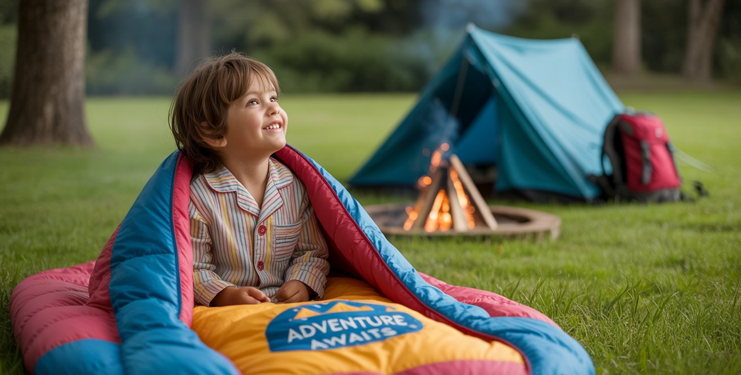When it comes to preparing your child for outdoor adventures, sleepovers, or camping trips, one essential item stands out: the kids sleeping bag. A properly chosen sleeping bag ensures not only a good night’s rest but also warmth, safety, and comfort for your child. In this comprehensive guide, we’ll walk you through everything you need to know to choose the best sleeping bag for your child’s needs.
Why a Kids Sleeping Bag Is Not Just a Smaller Adult Bag
A kids sleeping bag is specifically designed to suit the needs of children. While it might be tempting to hand down an adult sleeping bag, doing so can result in poor insulation, discomfort, and potential safety concerns. Kids require bags that are proportional to their size, easy to manage, and suited to their unique sleeping habits.
Children generate less body heat than adults, which means proper insulation is crucial. Additionally, features like glow-in-the-dark zippers, fun patterns, and easy-packing options make a big difference in whether your child embraces or resists using the bag.
Factors to Consider When Choosing a Kids Sleeping Bag
1. Size and Fit
Sleeping bags that are too large will not trap heat efficiently, while those too small may restrict movement and comfort. Look for size specifications based on age and height, typically segmented into toddler, youth, and junior categories. Choosing the right size will help your child stay warm and sleep more soundly.
A properly fitted sleeping bag also ensures safety. When a bag is too big, cold air pockets form, and your child’s body will struggle to warm the space. When it’s too tight, it can be uncomfortable and claustrophobic. Manufacturers often provide recommended height or age ranges to guide your purchase.
2. Temperature Rating
Always check the sleeping bag’s temperature rating to ensure it suits your intended environment. Ratings often come in ranges like:
- Summer: 35°F and above
- 3-Season: 20°F to 35°F
- Winter: 20°F and below
If you’re camping in mild conditions, a summer bag will suffice. However, for fall or spring outings, opt for a 3-season bag to avoid chilly nights. Winter bags are bulkier but essential for snowy, mountainous regions. Don’t rely solely on the rating; layering clothes and using a sleeping pad also affect warmth.
3. Shape: Rectangular vs. Mummy
- Rectangular Bags: Offer more space and are ideal for warm-weather or indoor use. They can often be unzipped and used as a blanket, which is great for sleepovers and casual use.
- Mummy Bags: Designed for colder climates with a snug fit and a hood to retain heat. The tapered design helps conserve body heat more effectively but may feel restrictive to active sleepers.
Your choice should depend on your child’s comfort preference and the climate where the sleeping bag will be used.
4. Weight and Packability
Kids may be expected to carry their own gear during camping or trips. Lightweight, compressible sleeping bags that pack into small stuff sacks are ideal. Look for features like stuff sacks with compression straps, which reduce the size further.
Weight also matters if you’re flying or hiking. Aim for bags under 3 pounds for ease of transport.
5. Material and Fill Type
- Synthetic Fill: More affordable, quick-drying, and performs better in damp conditions. Synthetic bags are hypoallergenic and generally easier to clean.
- Down Fill: Warmer and more compressible, but can be pricier and loses insulation ability when wet. Modern down bags may include water-resistant coatings.
The outer shell should be durable, water-resistant, and easy to clean. Look for ripstop nylon or polyester with a durable water-repellent (DWR) finish.
6. Durability and Ease of Cleaning
Children can be rough on gear. Look for reinforced seams, ripstop fabrics, and durable zippers. Sleeping bags that are machine washable are more practical. Some include removable liners, which make cleaning even easier and reduce wear on the main bag.
7. Special Features
Some thoughtful extras include:
- Built-in pillows
- Glow-in-the-dark zippers for easy nighttime use
- Internal pockets for storing flashlights, small toys, or snacks
- Fun prints and themes that appeal to kids
- Draft collars and zipper baffles for cold-weather bags
These features can turn a sleeping bag from a boring necessity into something your child looks forward to using.
Top 10 Kids Sleeping Bags in 2025
Based on current reviews, durability, safety, and comfort, here are our top picks:
- Kelty Big Dipper 30 – Adjustable sizing and solid insulation.
- Coleman Kids 50 Sleeping Bag – Affordable and great for warm nights.
- REI Co-op Kindercone – A parent favorite with fun designs.
- The North Face Youth Eco Trail – Eco-friendly and weather-resistant.
- TETON Sports Celsius Junior – A great option for colder climates.
- Morrison Outdoors Little Mo 20 Baby Sleeping Bag – Wearable and safe for infants.
- Wenzel Moose Youth Sleeping Bag – Soft lining and appealing graphics.
- Heytrip Kids Mummy Sleeping Bag – Lightweight with a compression sack.
- Naturehike Lightweight Kids Sleeping Bag – Compact and suitable for hiking.
- Wildkin Original Sleeping Bag for Sleepovers – Best for indoor use and nap time.
Each of these options caters to different needs, from cold-weather camping to cozy indoor sleepovers.
Age-Specific Recommendations
Toddlers (Ages 1-3)
Children under three should use sleeping gear designed specifically for toddlers. These wearable sleeping bags resemble sleeping suits and reduce the risk of suffocation. Brands like Morrison Outdoors specialize in safe, cozy bags for this age group.
Preschool and Elementary Age (Ages 4-8)
At this age, children benefit from lightweight, colorful bags that encourage independent use. Look for bags with easy zippers, interior pockets, and themed designs. Bags should be roomy enough to accommodate a growing child without being too large.
Tweens and Early Teens (Ages 9-13)
Older kids may be ready for more technical bags with features like draft collars, adjustable hoods, and compression sacks. These should still be youth-sized to ensure proper insulation. Some may even transition to adult-sized bags with smaller dimensions.
Indoor vs. Outdoor Use
Indoor
- Lower insulation needs
- Fun designs and themes (superheroes, animals, etc.)
- Often come with matching accessories like pillows or carry bags
- Easier to clean and maintain
Indoor bags are perfect for sleepovers, daycare naps, or even lounging at home. Since insulation is less critical, choose based on aesthetics and ease of use.
Outdoor
- Weather-resistant materials
- Higher insulation and durable zippers
- Better suited for camping or overnight outdoor trips
- Typically include a stuff sack and water-resistant shell
Outdoor sleeping bags should match the weather conditions and the length of the trip. Pair with a sleeping pad for added insulation and comfort.
Maintenance and Storage Tips
To extend the life of your kids sleeping bag:
- Always air out the sleeping bag after each use to prevent odors and mildew.
- Follow the manufacturer’s cleaning instructions. Most synthetic bags are machine washable.
- Store in a loose, breathable cotton sack or hang it. Avoid storing in compression sacks long-term.
- Inspect regularly for loose threads, zipper issues, or stuffing migration.
- Teach kids how to fold or stuff the bag properly to avoid damage.
Safety Tips for Using a Kids Sleeping Bag
- Never use an adult sleeping bag for infants or toddlers. It poses a suffocation risk.
- Ensure zippers are protected with guards to avoid skin pinching.
- Avoid over-bundling. Overheating can be dangerous, especially for younger kids.
- Use the sleeping bag on a flat, stable surface to prevent rolling.
- Keep flashlights or headlamps nearby for nighttime comfort.
- Avoid loose cords or strings around the bag that may pose choking hazards.
Frequently Asked Questions (FAQs)
Can I use an adult sleeping bag for my child?
It’s not recommended. Adult sleeping bags are too large and do not insulate properly for smaller bodies. A kids sleeping bag is designed specifically for children’s size and safety.
What temperature rating should I look for?
It depends on the environment. For general camping, a 3-season bag (20°F to 35°F) is usually appropriate. Always check local weather forecasts and plan accordingly.
How do I clean a kids sleeping bag?
Most synthetic sleeping bags are machine-washable. Use a gentle cycle with mild detergent and allow it to air dry. Avoid fabric softeners and high heat.
Are mummy sleeping bags too restrictive for kids?
Some children may find mummy bags snug. Look for models that provide extra foot room or slightly relaxed shapes to balance comfort and warmth.
How long will a kids sleeping bag last?
With proper care, a quality sleeping bag can last several years. Consider one with adjustable sizing features to accommodate growth.
What’s the best material for kids sleeping bags?
Synthetic materials are usually best for children due to their durability, ease of cleaning, and performance in damp conditions. Down bags are warmer but more expensive and require more maintenance.
Should I buy a waterproof sleeping bag?
Water-resistant sleeping bags are typically sufficient unless you’re camping in extremely wet environments. Pair the bag with a tent and groundsheet for added protection.
Can kids use sleeping pads with their bags?
Yes. Sleeping pads provide insulation from the cold ground and increase comfort. They are especially important in colder climates or uneven terrain.
Conclusion
Choosing the right kids sleeping bag can make or break your child’s camping or sleepover experience. By understanding your child’s needs, the environment where the bag will be used, and the key features to look for, you can make a confident, informed purchase. A well-selected sleeping bag ensures that your child stays warm, safe, and happy—whether they’re under the stars or on a living room floor.
Invest in a bag that matches both the conditions and your child’s preferences. Read reviews, compare features, and prioritize safety and comfort. With the right sleeping bag, your child will look forward to every overnight adventure, building memories and confidence in the process.
Whether you’re heading to the woods or planning a backyard campout, the perfect kids sleeping bag is out there—waiting to be unrolled.








